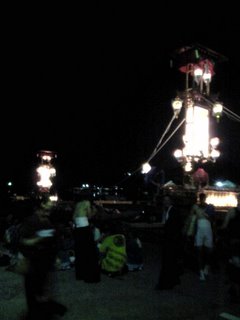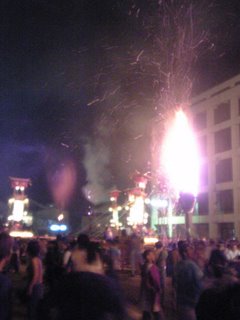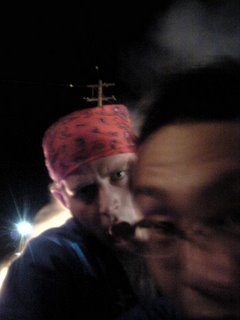The simplest translation is merely Festival, which does it little justice. Japan is a nation with one of the most coherent and continuous histories on the planet. In the book I’m reading now, Shogun by James Clavell, it was just mentioned that there has been an unbroken Imperial line in Japan stretching for 107 generations and that the emperor’s bloodline stretches all the way to the beginning of history, and beyond that into mythology, where the first Emperor is said to have been the son of the Sun Goddess, Amaterasu. That’s a long time and, mind you, the book takes place in 1600 A.D. No wonder tradition and its conservation play such an important role here. So many things have been done the same way for hundreds, if not thousands of years. Certainly, the appearances of things have changed, but at its heart, at its core, the underlying philosophies have remained largely untouched. If we go back some two thousand years or a mere two hundred, we would see Japan as a nation of fishermen and rice farmers, leading quiet, isolated lives, practicing and passing down skills of former generations. Of course, there is the whole feudal thing and the Lords, their vassals, the samurai, and the unique cultural and social implications that go with that, but once we establish everyone in their proper and accepted place, the picture of life becomes easy to grasp. The first major need of any human unit is, of course, food. Japan did not become a nation of meat-eaters until only fifty or sixty years ago, and before that, had primarily subsisted on rice, its geography is prime for rice-growing, and fish, it being an island nation and all. And, so, naturally, the importance surrounding these two events is paramount. Add to this Japan’s interesting religious amalgamation (Shintoism, Buddhism, and a unique local polytheism that places a kami (god) in every town, village, even house), and you can see the need for a special event in which to please the gods and ensure success in the year’s rice harvest and fishing expeditions. And so, to fill this great need, emerges the Matsuri, the great village festival, a time of celebration, merriment, revelry, and prayer for success. Every town across the land has its own Matsuri, each unique in some way. Of course, there are many similarities between them, but again, each town is also different. I have seen many Matsuris in my year here, but always as a tourist would, from the outside, merely being there, not in it, but outside, observing without much understanding. But, last weekend, I had a wonderful opportunity to see it from the Japanese side of things and would like to write a little bit about that.
I was invited by one of my teachers to his town’s local Matsuri, which took place over two days (last Friday and Saturday) in the northern part of the Noto Peninsula (I live right at its neck). The name of this particular one was the Abare Matsuri, which is loosely translated among the English speakers here as the Fire and Violence Festival. (Nice name, innit?) It took place in Ushitsu town, part of a larger town called Noto Town (recently in Japan, many villages and towns have unified, forming larger bodies – like my town of Shio and the neighboring town of Oshimizu joined last year and are both now Houdatsushimizu – but many of the local traditions, including Matsuris, have remained). Ushitsu is a fishing town, right on the coast of the Sea of Japan, and so this Matsuri, stretching from hundreds of years ago, was closely linked to wishing the fishermen success.
My friend Dipika and I left Houdatsushimizu right after work on Friday and made the two hour drive north. We were met by my teacher, who had taken the day off of work and had already been drinking for a significant amount of time when we arrived. He showed us into his house, into a large tatami living room, with a long table in the middle. Sitting around it were perhaps fifteen men of all ages, partaking in the massive quantities of food being brought out by the mother of the teacher and his sister. Let’s not forget to mention the copious quantities of Asahi and Kirin also present. Food magically appeared (and really, really good, well-prepared food too) and glasses kept getting refilled. We were shown where to sit and quickly joined in. The tables were literally overflowing and, failing to keep my ravenousness in check, I dug in. Having had my fill for a while, I began to observe and noticed a very curious thing. People would sit for a little while, eat, drink, and then leave, their spots soon filled by other people walking in. The doors of the house were open. People could come and go as they pleased, but the moment someone walked in, he/she would be shown a place, loaded with food and drink, and invited to some conversation. The master of the house sat at the head of the table, and everyone came in and complemented him. We sat for quite a while, so I was able to see many people come and go. Eventually, through my own deduction and conversation with Hisada sensei, I figured out that at matsuri time, many houses in a town opened their doors like this, and since this was a community (and a close knit one at that, the notion of privacy or intimacy is not developed in Japan) and almost everyone from the neighborhood knew each other, people visited others freely like this. We were invited specially, not being from the town and foreigners at that. But, to the locals, this was a long-established tradition. I had actually experienced it before (last summer), but slightly under a different (ahem) mindset, so didn’t think about it much, but now it really hit me. This kind of generosity and warmth was entirely amazing and fascinating. In a time of Matsuri, the kindness of Japanese people, for which they are renowned anyway, is expanded out of all proportion. So, we sat and drank some more, until it was time to go and meet my arch-nemesis for the evening, the kiriko. Beer in hand, we left the house and along with other revelers, made our way down the tiny streets and alleys to where it was waiting for us, huge, heavy, and fearless…
 There’s a picture of it. Forgive me, but I carelessly forgot my camera, and so had to settle for the much lesser quality of my cell phone. What is it, you may ask? Well, I don’t really know how to describe it best. At this festival, there were about 30 or 40 of these things, each manned by up to 60 drunken men. Each neighborhood of the town has its own kiriko, as well as its own particular happi (the little coat everyone wears), its own chant, and its own taiko (drum) rhythm. The kiriko has that thing in the middle, around the base of which children sit, playing all sorts of musical instruments. Right in front of it is a big taiko drum, which means at least two drummers there. But here’s the basic idea. These 60 men (in our case it always seemed to be way less, thus adding to my problems) carry the bugger on their shoulders, chanting a wicked series of words, following the drum beat, occasionally lifting the whole thing up even more, in tune with the rhythm. The activity is quite mind-boggling actually, and you can imagine how bad it was for me, being not an insignificant amount taller than the rest, having to stoop way down to get myself under it and also having to bear a significant part of the weight.
There’s a picture of it. Forgive me, but I carelessly forgot my camera, and so had to settle for the much lesser quality of my cell phone. What is it, you may ask? Well, I don’t really know how to describe it best. At this festival, there were about 30 or 40 of these things, each manned by up to 60 drunken men. Each neighborhood of the town has its own kiriko, as well as its own particular happi (the little coat everyone wears), its own chant, and its own taiko (drum) rhythm. The kiriko has that thing in the middle, around the base of which children sit, playing all sorts of musical instruments. Right in front of it is a big taiko drum, which means at least two drummers there. But here’s the basic idea. These 60 men (in our case it always seemed to be way less, thus adding to my problems) carry the bugger on their shoulders, chanting a wicked series of words, following the drum beat, occasionally lifting the whole thing up even more, in tune with the rhythm. The activity is quite mind-boggling actually, and you can imagine how bad it was for me, being not an insignificant amount taller than the rest, having to stoop way down to get myself under it and also having to bear a significant part of the weight.So, we arrived, and stood around, waiting. About ten or so kirikos were lined up and we were the last on this street. Everyone was in a cheery mood, dudes walking around with rather large bottles of sake, giving, sharing. And to refuse sake at a festival is akin to treason, so I had to partake. But, as many may not know, ever since that trophy-bowl-sake-drinking-dive-into-rice-field-fall-off-bike-and-wake-up-really-late-for-work incident last fall, my relationship with sake has not been particularly good. So, I had to pull the old tip the bottle but don’t drink move to satisfy the villagers, as well as the gods. Finally, after tense waiting and watching the other kirikos move out, we got into position, shoulder cushions in place, and after a little “se no” lifted the crapper. Oh MY GOD. It was heavy, really heavy, but we had to work as a unit and I knew that if I gave in, the whole thing would come down. Now you gotta believe this thing weighs at least a ton, so it was a monster to carry. Plus there was the chanting, which helped a bit, and the almost out of control swaying. Remember, we were carrying the kiriko (a good 20 feet high) as well as probably around ten people (mostly kids but still). Slowly, down the street, around some corners, almost into a river, but not quite. It was like a parade of these things, and slowly both sides of the street began to fill up with people who were watching and any number of times we almost took the whole thing on top of them. No wonder people die at these things. I thought we’d seen it all, but that wasn’t the half of it. We had carried the puppy for a good forty minutes, when we arrived at the festival’s main square, and here is what we saw.

Three large poles with clumps of easily burnable straw and wood at the top. Standing at least thirty feet in the air, these poles formed the center of a large square, flanked to one side by a harbor and the other by massive throngs of people. As all the kirikos stood by at the entrance, each of the clumps was lit and gradually erupted into tiny little infernos, lighting up the night. Then, to mad chants and cheers, the villagers, me included, proceeded to carry the kirikos in circles around these massive flames. It is really difficult to capture this in words. Each kiriko can stand on the ground on its own, balanced on the base. But, when it is lifted and no part is touching the ground, its entire weight rests on the shoulders of rather intoxicated individuals. It is enough that just one of them lets go, thereby increasing the burden of those around him and the whole thing comes crashing down to the ground, either front end or back end. It always balances ultimately, but when the strength gives, everyone is at the mercy of this wooden giant. Any number of times it happened, and any number of times I and everyone had to duck out of the way. Now, its one thing to carry it down a street, but its quite a different one to do so in circles. And even more different when the circles are around huge bonfires in the air that are spewing burning embers that are landing everywhere, including inside of my ear, giving me a nice little burn. And even more considering there are ten or so kirikos going in the circle at any one time, each one dependent on the one in front of it not to collapse. Ours did, and others had to dive out of the way. Needless to say, the whole thing became a blur at some point, and right now, really seems surreal. At some point, we stopped, rested. Then carried it back to the starting point, with several stops along the way. When it was all said and done, I plopped down to the ground, in more pain than I was prepared to experience. We eventually hobbled back to the house, snacked a bit, and I hit that futon like a pile of bricks falls to the ground.
The next day, my shoulder, neck and at least four vertebrae were in massive pain. I could barely move laying down, much less walk. But, as a nice sturdy 6 course Japanese breakfast was waiting for me down stairs, I willed myself into action. We sat around some more, then said our farewells, and on the way to the car, went to pay our respects to the kiriko, bang on the drum, relieve last night’s glory. Then, Dipika and I drove off, leaving Hisada sensei to his festival. The second day, as I subsequently heard, is a lot more difficult than the first. They started carrying the thing around 3:30 PM, taking a break around 7:00 to eat, drink, then continuing with it until the neighborhood of 4 in the morning. Surrounded by mad festival crowds, gallons upon gallons of sake, and that second part of the Fire and Violence Festival…
A day later, I was still baffled. Sure, in the times of superstition and more powerful religious belief, such an exercise could be seen to entertain the gods, thus making them happy and granting a successful fishing venture. But in this modern day and age, is there really such a need to continuously engage in such foolhardy and seemingly dangerous reli
 cs of the past? I thought for a bit and then in came to me, somewhat embarrassingly, for all its palpability. In a land where the individual counts for little and the group, no matter how big or small, counts for everything, the Matsuri is its lifeblood. The notion of community, of everyone working together, blending into a common unit and task, trumps many other values here. It is evident at school, where the students will never answer a question unless they have first consulted with their friends. It is evident at work, where endless meetings are necessary to resolve the slightest of issues. It is evident in the neighborhood, when hundreds of people get up at six in the morning on a Sunday to go voluntarily clean the beach. It is visible everywhere. And once the drunken buffoonery, the apparent mayhem, and the general revelry of the Matsuri is seen through and digested, it is certainly present there as well. From the tiniest village to the biggest city, the Matsuri is a way for the folks of this land to come together and celebrate themselves and all they have worked for, to remember thousands of years of history and tradition, and to participate in an event far greater than themselves. I am forever grateful to have played a tiny role in such an amazing spectacle.
cs of the past? I thought for a bit and then in came to me, somewhat embarrassingly, for all its palpability. In a land where the individual counts for little and the group, no matter how big or small, counts for everything, the Matsuri is its lifeblood. The notion of community, of everyone working together, blending into a common unit and task, trumps many other values here. It is evident at school, where the students will never answer a question unless they have first consulted with their friends. It is evident at work, where endless meetings are necessary to resolve the slightest of issues. It is evident in the neighborhood, when hundreds of people get up at six in the morning on a Sunday to go voluntarily clean the beach. It is visible everywhere. And once the drunken buffoonery, the apparent mayhem, and the general revelry of the Matsuri is seen through and digested, it is certainly present there as well. From the tiniest village to the biggest city, the Matsuri is a way for the folks of this land to come together and celebrate themselves and all they have worked for, to remember thousands of years of history and tradition, and to participate in an event far greater than themselves. I am forever grateful to have played a tiny role in such an amazing spectacle.